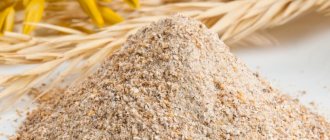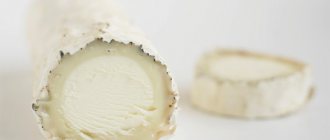Sesame, or “Sesame” as it is also called, grows up to two and a half meters in almost six months. The sesame fruit is similar to a box in which the seeds are stored. And if you touch it very lightly - a moment... and the seeds are already in your palm. “Open sesame” is a suitable password for both entering Ali Baba’s cave and collecting sesame grains.
Sesame seeds, in addition to basic fats, carbohydrates and proteins, contain a large amount of calcium, which makes them very beneficial for teeth, hair, nails and bones. A small handful of seeds can temporarily dull the feeling of hunger, and at the same time provide a healthy snack. But remember the energy value of the product - 582 kcal/100 grams
.
Useful properties of sesame
- Sesame is the main source of lime in the body. If you consume 10 grams of sesame seeds per day, the lack of lime will be replenished.
- A beneficial property of sesame seeds is the ability to remove harmful metabolic products from the human body. For this, it is better to use sesame oil rather than seeds.
- Sesame oil has anti-inflammatory, hemostatic, laxative properties
. The oil contains phosphorus, iron, zinc, magnesium, as well as the daily requirement of calcium. - Among the beneficial functions of the oil: healing the skin, treating the nasal mucosa, cleansing the lungs, improving vision, and also has a strong stimulating effect. Sesame oil is good to use for asthma, cough, shortness of breath, and joint diseases. It can also be used by people with diabetes because it does not contain sugar.
The calorie content of the oil is 899 kcal/100 grams.
Harm of sesame oil
This is one of the “delicate” oils that does not tolerate heat cooking. In India, when heated, a varnish similar to drying oil was obtained from it. Hot oil should not be consumed as food. The maximum is warm, about 27 degrees Celsius. It is not recommended to store oil in a transparent bottle in the light, as this may cause the breakdown of some fatty acids and loss of beneficial properties. The product also reacts with oxygen, so it should be stored in a tightly sealed glass container.
Sesame oil can cause allergies. If you experience cold symptoms, swelling of the nasopharynx, or runny nose, you should immediately consult a doctor and stop taking the oil. Rashes and clogged skin pores are also possible if you do not cleanse it sufficiently before using oil treatments. Masks and massages with oil should be carried out only on thoroughly cleansed skin, otherwise they disrupt the natural secretion of the sebaceous glands. In any case, observe moderation and consult a specialist before starting to use any folk recipes.
Sesame soup
First, finely chop a bunch of green onions, then cut into slices and fry 4 cloves of garlic. The garlic must be fried for a minute in sesame oil with one tablespoon of sesame seeds.
Next, finely chop 200 grams of white cabbage and add to the onion and garlic. In the same frying pan, add 200 grams of chopped sweet pepper, the same amount of carrots and simmer under the lid for no more than 5 minutes.
After all, add water or vegetable broth to the resulting mixture and bring to a boil. At the very end, add salt, pepper, and the necessary spices to taste. Lastly, add 300 grams of egg noodles and cook until done. You can treat yourself to lean crackers; they are perfect for this soup. Bon appetit!
Calorie content of sesame
Sesame itself is quite high in calories and filling. There are 569 kcal per 100 grams of product. Moreover, this figure refers to whole and unpeeled seeds. Sesame that has been peeled will have more calories - 582 kcal per 100 grams. And here a logical question arises: how much sesame exactly do you need to eat per day in order not to gain weight and to saturate the body?
If you are afraid of gaining weight, then do not eat a large amount at a time, especially if the sesame is mixed with sugar, such as in kazinak. The main thing here is to stop. Because sesame itself, present in small quantities in baked goods and salads, does not harm the figure. But kazinaki and sesame-based desserts can unauthorizedly add centimeters to you.
Pregnant women can consume a spoonful of sesame seeds per day to replenish calcium in the body. You can add seeds to desserts, salads, cereals and other dishes. In general, look at how you feel: if your body lacks calcium, you will eat a ton of sesame. Such a deficit cannot be satisfied with sesame seeds alone, and there is no need for extra pounds. Therefore, it is better to “treat calcium deficiency comprehensively,” that is, with foods rich in this element and vitamins.
There is no need to be afraid of sesame, because it has no contraindications - only individual intolerance.
Therefore, feel free to go to the supermarket, find a shelf with oils and take a bottle.
And if you are not on a diet, then you can treat yourself to an incredibly healthy sesame casinak. In a word, quickly discover Sesame! 8 votes
I have already talked about sesame as the champion in calcium content per 100 grams. However, sesame is interesting not only for its calcium. Let's look at its vitamin and, most importantly, mineral composition.
The data I use is confirmed by research from the US Department of Agriculture - “Agricultural Research Service”
.
In the tables below I provide data on the content of a particular vitamin or element in milligrams per 100 grams of sesame.
For ease of measurement, 100 grams of sesame is approximately 11 tablespoons
. 1 tablespoon contains 9 grams of sesame seeds.
In each table, the last column is the norm for a pregnant woman per day. Again, for convenience, so that you don’t have to look for anything additional.
So let's get started.
Sesame – composition of vitamins and microelements:
How to take sesame paste
Few people eat tahini in its pure form. The paste has a specific taste and high fat content. It is better to add it in small quantities to salads, sauces, and marinades. Fans can simply spread tahini on bread. It is advisable to eat no more than 2-4 tbsp per day. l. pure sesame paste.
We recommend reading: Sprats: benefits and harm to the body
Fans of oriental sweets can make a spread with the addition of fruit syrup. In Greece, tahini with honey is popular. In some countries, the product is used to prepare halva.
Most often it is included in the diet in the form of dressings. You can make salad dressing by mixing:
- 2 tbsp. l. water, tahini, lemon juice;
- ½ tsp. paprika;
- 1 clove of garlic;
- salt pepper.
Advice! The colder the water, the lighter the sauce will be. Some people recommend adding ice when mixing the ingredients.
The sauce made from tahini is absorbed better than pasta in its pure form; it is used as a dressing for salads, meat, and vegetable dishes.
Table: Content of vitamins in sesame
| Vitamin | Content in 100 g of sesame, in mg | Daily vitamin intake during pregnancy |
| Vitamin B1 | ||
| Vitamin B6 | ||
| Vitamin PP, Nicotinic acid | ||
| Vitamin B9, Folic acid | ||
| Vitamin E |
As you can see from the tables, among the vitamins, sesame contains B vitamins, practically does not contain vitamin E, and does not contain vitamin C, A, or B12 at all.
However, the mineral composition is simply luxurious. 100 grams of sesame is enough to saturate you with your daily requirement of iron, magnesium, phosphorus, get 2/3 of your daily requirement of calcium and half of zinc
. Simply a champion in macro and microelements.
Composition of sesame oil
It is safe to say that the composition of sesame oil is completely balanced and therefore this product is extremely beneficial for human health. Thus, sesame seed oil contains a sufficient amount of vitamin E, which is simply necessary for beauty and an attractive appearance. Perhaps this is why many representatives of the fair sex have long replaced other vegetable oils with this product.
In addition, sesame oil also contains beneficial fatty acids, which are present in this product in sufficient quantities. These are Omega-6 or polyunsaturated linoleic acid and Omega-9 - monounsaturated oleic acid.
How to eat 100 grams of sesame?
Everything is fine with sesame except for the moment when you start to think how to eat it in such quantities?
Well, firstly, you should not focus on 1 sesame as a source of calcium; you must diversify the products from which you get it. So you don’t need to eat 100 grams of sesame seeds every day.
However, from my practice I can say that sesame complements perfectly, its bitterness is not felt in them, you can put about 1-2 tbsp per 300 grams.
Pairs perfectly with any greens, tomato, cucumber, cabbage, and seaweed salads.
One raw foodist told me that he dips apple and banana slices in raw sesame seeds.
But of course the best help in this matter is sesame milk, soak it, add dates, grind it and drink it. Here you can eat half a glass of sesame at one time.
Here I gave my recipe for sesame milk:
Many people recommend eating urbechi - nut pastes made from sesame seeds. However, I doubt the benefits of Urbechi. First, the paste must be made from raw seeds and contain no sweeteners. It is difficult to find such a paste on sale. Secondly, the paste should be freshly ground to reduce the time of fat oxidation. After all, they oxidize from grinding, mixing with oxygen, or heating. When oxidized, free radicals are released.
I recommend eating sesame only raw, look for raw food recipes with sesame, there are breads, cookies and candies. If you want to replenish your micro and macronutrients, eat it raw. And if you just enjoy it then, you can already fry and bake.
Sesame is one of the oldest oilseed plants. Particularly common in Eastern countries. It is grown mainly for the production of sesame seeds, which are valued for their high taste and healing properties. Widely used in culinary and medical fields. Serves as a raw material for obtaining oil, which is used in cosmetology as an effective nourishing and moisturizing agent for hair. Included in anti-aging skin masks.
IT IS IMPORTANT TO KNOW! Fortune teller Baba Nina:
“There will always be plenty of money if you put it under your pillow...” Read more >>
- Show all
What are the benefits of sesame paste?
The beneficial properties of tahini are due to its rich vitamin and mineral composition. The fiber, organic acids, and unsaturated fats contained in the paste have a beneficial effect on health.
Regular consumption of sesame paste (tahini) is recommended for:
- prevention of cancer development;
- improving the functioning of the blood coagulation system;
- removal of toxins and harmful substances from the body;
- liver cleansing.
The paste stimulates the body's defenses and improves the condition of blood vessels. It is recommended for use by people diagnosed with the following diseases:
- diabetes;
- atherosclerosis;
- neurasthenia;
- depressive disorders;
- hypertension;
- arthritis.
This product speeds up the recovery of patients with infectious diseases and protects against seasonal colds. Under the influence of substances contained in sesame paste, the production of white blood cells is triggered, which destroy pathogenic microorganisms.
Comment! When planning to include tahini in your diet, you should consider that the product has a mild laxative effect. The fatty acids contained improve the functioning of the gallbladder and liver, accelerating the process of digesting other foods.
Doctors recommend including tahini in the diet in the autumn-spring period; the substances contained in the paste stimulate the production of immune cells and destroy pathogens of infectious diseases
For women
Doctors advise women to regularly consume sesame paste in small quantities. The benefits become noticeable after 1-2 months of taking this product. Under the influence of the contained substances:
- skin condition improves;
- hair loss stops;
- immunity is strengthened.
The paste is useful for women of any age, but its effect is most pronounced during the premenopausal period. Tahini is a source of phytoestrogens. When consuming sesame paste, it is possible to prevent the development of hormonal imbalance and eliminate menopausal disorders. Women note that hot flashes disappear, sleep and mood normalize. Phytoestrogens protect against the development of cancer associated with the production of hormones - breast and ovarian cancer.
We recommend reading: Why palm oil is harmful, photos and reviews
Due to its high calcium content, tahini is recommended as a means to prevent osteoporosis. If this element enters the body in the required quantities and is completely absorbed, then bone tissue does not thin out or become more fragile.
For men
Not only women, but also men can appreciate the beneficial properties of sesame paste. Tahini is an excellent remedy for increasing libido and normalizing erectile function. This effect is due to the inclusion of a large amount of zinc in the composition. This element is necessary for the production of the main male hormone - testosterone.
The fatty acids contained stimulate the production of serotonin, the hormone of happiness. As a result, the man becomes less tense, and signs of chronic fatigue and depression disappear.
The beneficial effect on blood vessels and the heart reduces the risk of developing hypertension, heart attacks and strokes.
For children
Before including sesame paste in the diet of young children, you should make sure that there is no allergy to this product. It is advisable to introduce it gradually.
Children are allowed to give tahini after one year. But many pediatricians advise waiting until 3 years. At this age, the digestive system becomes more mature. By following this recommendation, the risk of developing allergies or intolerance reactions is reduced.
Sesame paste saturates the child's body with vitamins and mineral elements; it is advisable to give children no more than 1 tsp per day. tahini
When losing weight
Despite the high calorie content of sesame paste, it is recommended to include it in the diet of people who are trying to lose weight. The methionine included in the composition cleanses the body, removes toxins and harmful substances, and reduces the load on the liver.
Warning! When consuming pasta, digestion improves and metabolism starts. But obese people can add it to the menu only in small quantities; 1-2 tablespoons per day will be enough.
Description
Sesame refers to white, oily and fragrant seeds, which are also called “sesame.”
. This plant is native to South Africa and is especially popular in the cuisines of Japan, China, Vietnam, and India. In gastronomy, the seeds are used whole, fresh or roasted, which improves the taste of dishes. They are added as a seasoning when cooking.
The plant has elongated oblong capsules filled with small seeds of different colors: white, black, yellow, brown. A special feature is a persistent spicy aroma. Black is suitable for dressing salads and desserts, white is in perfect harmony with baked goods. There are also differences in taste: white has a pleasant nutty note, black has a bitter note. The oil is obtained from black sesame seeds as they are oilier.
White sesame seeds must be peeled. Black does not change color even after cleansing; the nucleoli remain dark. For medicinal purposes, it is recommended to eat seeds with the shell, since most of the vitamins and minerals are contained in it.
The chemical composition contains a unique number of useful components. Therefore, this remedy has been known in folk medicine for a long time. For example, black sesame contains much more iron than white sesame. Therefore, it is indicated for use by people suffering from anemia and exhaustion.
Benefits of sesame oil
Being a valuable food product, as well as an effective medicine, sesame oil has a beneficial effect on health when consumed regularly. Thus, the benefits of sesame oil are manifested in the treatment of hypertension, lipid metabolism disorders, as well as inflammatory diseases of the joints. It is due to these properties that it is recommended for osteoporosis. In addition, in case of obesity, sesame seed oil promotes weight loss, and in case of exhaustion, it helps build muscle mass.
In India, they have long learned to use it as a preventive and traditional medicine. There it is considered an incredibly healing substance that can remove toxins and poisons from the body. It is believed that the benefits of sesame oil are especially noticeable for pulmonary diseases, dry cough, shortness of breath and asthma.
Chemical composition and nutritional value
Sesame seeds are valued for their rich biochemical composition and the content of a large amount of healthy oil. It has a beneficial effect on the functioning of the human body, especially on the digestive system. It contains a lot of:
- vitamins;
- amino acids;
- glycerol ethers;
- triglycerides;
- organic, saturated and polyunsaturated fatty acids;
- carbohydrates and protein.
Among the vitamin series, it should be noted: A, B, PP, E, C. The mineral composition is no less solid, where phosphorus, calcium, magnesium, potassium, and iron prevail. According to scientific research, the antioxidants in the seed can last for about 10 years. Also found in the composition are phytin, which helps restore mineral balance, and beta-sitosterol, which lowers cholesterol levels in the blood.
To extract maximum benefits from sesame seeds, it is recommended to consume them in a soaked or heated state.
Due to the excess fat in the seeds, the calorie content is quite high: about 550–580 calories per 100 grams.
Energy value (BJU): proteins - 19.5 g, fats - 48.8 g, carbohydrates - 12.4 g. Sesame is a rather heavy food, so obese people should be careful: the optimal rate is 1 teaspoon per day.
Composition and calorie content of sesame
Sesame seeds, like any other grain, have a high calorie content, and therefore people who are trying to lose weight should approach its use with caution and strictly dose the product in food.
The calorie content of sesame is 565 kcal per 100 g of product, of which:
- Proteins - 19.4 g;
- Fats - 48.7 g;
- Carbohydrates - 12.2 g;
- Dietary fiber - 5.6 g;
- Water - 9 g;
- Ash - 5.1 g.
But for raw foodists, vegans and people who limit their diet in one way or another, sesame, on the contrary, is recommended to be consumed daily.
The seeds of this plant contain many useful components, which, in conditions of refusal of certain products, can satisfy the body's need for many macro- and microelements, vitamins, as well as essential acids. Macroelements per 100 g:
- Potassium - 497 mg;
- Calcium - 1474 mg;
- Magnesium - 740 mg;
- Sodium - 75 mg;
- Phosphorus - 720 mg.
Among the microelements in sesame, only iron is present, the amount of which is 16 mg per 100 g.
Vitamins per 100 g:
- Vitamin B1 - 1.27 mg;
- Vitamin B2 - 0.36 mg;
- Vitamin E - 2.3 mg;
- Vitamin RR, NE - 11.1 mg.
Essential amino acids per 100 g:
- Arginine - 1.9 g;
- Valine - 0.886 g;
- Histidine - 0.478 g;
- Isoleucine - 0.783 g;
- Leucine - 1.338 g;
- Lysine - 0.554 g;
- Methionine - 0.559 g;
- Threonine - 0.768 g;
- Tryptophan - 0.297 g;
- Phenylalanine - 0.885 g.
Fatty acids per 100 g:
- Omega-6 - 19.6 g;
- Saturated - 6.6 g;
- Monounsaturated - 19.5 g;
- Polyunsaturated - 19.6 g.
Digestible carbohydrates per 100 g:
- Mono- and disaccharides (sugars) - 2 g;
- Starch and dextrins - 10.2 g.
It should be noted that the seeds also contain a special substance called sesamolin - the strongest natural antioxidant. This one component characterizes the product as extremely useful: it not only rejuvenates cells, but also strengthens the immune system and has a beneficial effect on the nervous system, reducing stress and improving mood.
Beneficial features
The rich chemical composition of sesame provides a wide range of beneficial properties:
Sesame oil is widely used in traditional medicine. It is used to make ointments, emulsions, compresses, and plasters. It can improve blood clotting. It also has a mild laxative effect, so it is used for chronic constipation and hemorrhoids. Additionally, enemas are given, which relieves inflammation in the intestines.
Taking sesame oil internally, in its pure form, helps cope with stomach ulcers and gastritis. The body is also cleansed of waste and toxins.
In cosmetology it is used as an emollient and nourishing agent that effectively copes with inflammation and accelerates healing. It is often used for massage and used to remove makeup. Regular cosmetic procedures using sesame seeds relieve acne, fine wrinkles and skin irritation. When applied externally, the oil creates a protective layer on the skin from ultraviolet radiation.
When losing weight, only black seeds in a shell, enriched with fiber, are indicated. Eat only fresh, without heat treatment. In this case, it is not recommended to take oil due to its increased calorie content.
For women
Due to its rich antioxidant content, sesame has a beneficial effect on the skin and the body as a whole. Therefore, women who regularly use it look younger and more beautiful. It should be noted the positive effect of this product on the sexual sphere, especially in combination with flaxseeds and poppy seeds.
Since it contains a lot of female hormones, it is recommended to include such a supplement in the regular diet of women on the eve of menopause and with its onset. The oil should be taken during breastfeeding, which increases the quality of milk and protects against the development of inflammatory processes in the breast.
A tablespoon of sesame seeds contains the required daily dosage of all substances important for the body.
For pregnant
During pregnancy, you can eat sesame, but in measured quantities, based on your individual tolerance to the product. What are the benefits of seeds for pregnant and lactating women:
- It influences the development of the fetus, being a valuable source of vitamins and microelements.
- Easily absorbed by the body without creating heaviness in the digestive system.
- During lactation, it increases milk production and makes it fattier (it is enough to eat 1 teaspoon per day, otherwise breast milk will begin to taste bitter).
- Replenishes the lack of calcium and helps the healthy formation of the baby's bone skeleton.
- Relieves constipation, improves intestinal motility.
- Helps maintain good health and quickly restore strength after childbirth.
For men
Sesame is often called a natural aphrodisiac. For best results, it is recommended to fry it and eat it with honey and nuts. The seeds have a positive effect on the male body:
- Normalize the production of female and male sex hormones.
- Prevent the development of cancer.
- Improve reproductive abilities: increase potency, increase sperm production and quality.
It has been scientifically proven that sesame restores healthy blood circulation not only throughout the body, but also in the pelvic organs. This increases erection and increases the duration of sexual intercourse. And amino acids activate the production of testosterone, which is responsible for overall well-being and full functioning of the sexual sphere.
For children
There are no specific restrictions on use in children. They focus in each individual case on the individual characteristics of the body. If there is no allergy to nuts, then a small child can be given a piece of kozinak. This will have a beneficial effect on teeth that are breaking through, since there is 3 times more calcium in sesame than in milk.
The rich mineral component has a positive effect on the functioning of the liver and pancreas. If for an adult the optimal daily intake is 3 teaspoons, then for a child one will be enough. The same rule applies to oil.
Beneficial properties of sesame oil
Sesame oil is considered a cure for many diseases. Recent studies have shown that its antioxidant properties can improve the effectiveness of melanoma treatment. In addition, a couple of teaspoons of this oil is recommended for all those who have a family history of cancer.
This oil contains calcium, phosphorus, and large amounts of vitamin E and A, so it is recommended for strict vegetarians who do not consume dairy products and may be deficient in calcium. Due to its vitamin and mineral composition, the oil speeds up metabolism, improves food absorption, and is recommended for thyroid diseases.
This product is sometimes called the king of oils. Indeed, it contains not only linoleic and oleic fatty acids, but also phytosterol. The latter is a natural analogue of estrogen. Therefore, sesame oil is recommended to be introduced into the diet during premenopause. Those who, in pursuit of thinness, have acquired amenorrhea, should drink a tablespoon of this oil 20-30 minutes before breakfast to stimulate the ovaries. In any case, you can add it to a vegetable salad, the main thing is not to mix it with hot dishes, as most of the antioxidant properties are lost.
It is known that a massage with sesame oil can relieve muscle pain due to overwork and help you recover after a hard workout. In India, this oil is used simply as a moisturizer or even an anti-aging agent, used as a regular after-shower cream. And sesame oil infused with rose petals is considered the “royal remedy” against wrinkles. It is applied at night to clean facial skin. To strengthen dry hair, apply the oil to a clean scalp for half an hour and then rinse with water and lemon juice.
Medicinal use
To get the maximum medicinal benefits from sesame seeds, you need to take them correctly for specific health problems. It has long been used as an effective remedy for any diseases of the upper respiratory tract and asthma.
There are a number of recipes based on sesame seeds that help fight the following diseases and problems:
| Indications | Application |
| Lingering cold | It is recommended to steam the oil and quickly rub it into the chest area. Wrap a warm scarf on top |
| Decreased erectile function | Women and men should eat 1 tablespoon of seeds daily, chewing thoroughly. For best results, pre-soak them in water. |
| Ulcers, gastritis, chronic constipation | Take 0.5-1 tablespoon of sesame oil three times a day |
| Excess weight | The seed is first ground in a coffee grinder. Take 1 tablespoon three times a day and only before meals. Drink with plenty of water. This regimen helps you lose a few kilograms of excess weight. |
| Caries, gingivitis, periodontitis, tartar | Take 1 large spoon of oil into your mouth, but do not swallow. Hold it for about 2-3 minutes, performing sucking and rinsing manipulations. Then they spit it out. If you perform this procedure regularly, you can forget about caries. |
Use in cooking
This product has a pronounced pleasant aroma and has long been traditionally used in Asian cuisine, but due to its benefits and taste, it has gained popularity among the culinary delights of other nations.
The oil is used both in its pure form and as an ingredient in various sauces for meat, fish, and salads - for this, a dark variety of the product is used. For deep-frying and frying, light, refined oil is more suitable, which does not have a specific odor when heated.
There are a lot of recipes in which it is used. Here are a few of them:
- Eggplant salad. Cut 2 medium eggplants into strips, add salt and place on a paper towel to remove bitterness. At this time, prepare the sauce - mix 2 tablespoons of soy sauce, a tablespoon of oil and a few drops of vinegar. Pour this sauce over the eggplants, sprinkle with finely chopped garlic and herbs on top. Mix the salad and put it in the refrigerator for 2 hours to soak.
- Fried chicken fillet.0.5 kg. marinate chicken fillet in a sauce of 30 grams of honey, 3 tablespoons of soy sauce and a pinch of pepper. Pour 150 - 200 ml of sesame oil into a deep frying pan, heat it and fry the fillet until golden brown.
Selection of seeds and their proper storage
To buy a quality product, you need to pay attention to the following indicators:
- dryness and friability of seeds;
- lack of bitterness in taste;
- the presence of husks (it has more benefits and a longer shelf life).
Unhulled sesame keeps well in a regular food container with an airtight lid. Place in a dark and cool place, without access to dampness. It is advisable to keep seeds without shells in the freezer or refrigerator. Otherwise they quickly become rancid.
Summarize
- Tahini is made from roasted and ground sesame seeds.
- It is rich in important nutrients such as fiber, protein, copper, phosphorus and selenium, and may reduce the risk of heart disease and inflammation.
- What's more, test-tube and animal studies suggest that sesame seeds may have anti-cancer properties.
- Tahini is a versatile and easy-to-use ingredient, making it an excellent addition to a healthy, well-balanced diet.
Tags: Sesame, Tahini
- Related Posts
- Stevia: benefits and harm to the body
- Is pink Himalayan salt healthier than table salt?
- What are liquid amino acids and are they healthy?
« Previous entry
Contraindications
Sesame has a number of contraindications. Its use may cause significant harm to people with:
- increased blood clotting;
- tendency to thrombosis;
- the presence of kidney stones.
The product can be stored at room temperature for no more than 3 months, in cool storage for up to 6 months.
When frozen, quality indicators remain normal for about one year. But the oil can be stored for years, and environmental conditions do not affect it in any way. Even being in the sun, its beneficial composition will not be lost.
And a little about secrets...
The story of one of our readers, Irina Volodina:
I was especially distressed by my eyes, which were surrounded by large wrinkles, plus dark circles and puffiness. How to completely remove wrinkles and bags under the eyes? How to deal with swelling and redness? But nothing ages or rejuvenates a person more than his eyes.
But how to rejuvenate them? Plastic surgery? I found out - no less than 5 thousand dollars. Hardware procedures - photorejuvenation, gas-liquid peeling, radio lifting, laser facelift? A little more affordable - the course costs 1.5-2 thousand dollars. And when will you find time for all this? And it's still expensive. Especially now. Therefore, I chose a different method for myself...
Calories, kcal:
Proteins, g:
Carbohydrates, g:
Sesame (Indian sesame, simsim, sesame) is a herbaceous annual of the Pedal
and its fruits. Sesame began to be grown several thousand years BC in Persia and India, where it was considered the spice of immortality. Small flat sesame seeds are drop-shaped, have a specific smell and a delicate nutty taste. There are several types of sesame based on color - yellow, reddish, and traditional sesame that is almost white. Light sesame seeds are hulled black sesame seeds.
Calorie content of sesame
The calorie content of sesame is 565 kcal per 100 grams of product.
Sesame contains fiber, which has a beneficial effect on digestive processes and improves intestinal motility. Phytosterol, which is a plant analogue of cholesterol, does not lead to the formation of cholesterol plaques on the walls of blood vessels. Sesame contains vitamins and minerals, including: , . Phytoestrogens, analogues of female sex hormones, which prevent the occurrence of malignant tumors, especially in the mammary gland, are found in sesame. Daily consumption of raw sesame should not exceed 2-3 teaspoons.
Harm of sesame
Sesame, for all its benefits, contains axalates, which contribute to the formation of kidney stones, so excessive consumption of this product is not recommended for those who have a predisposition to urolithiasis. Allergy to sesame is quite common.
Selection and storage of sesame
Sesame is a perishable product, therefore, when purchasing it in sealed packaging, you should carefully study the date of manufacture and the expected expiration date (calorizator). When buying loose sesame, you should give preference to dry seeds, without signs of sticking, caking, and without the smell of mold or rancidity.
It is better to store sesame seeds in ceramic or glass containers with a sealed lid, in a cool place out of direct sunlight. You can store sesame seeds in the refrigerator.
Sesame in cooking
Sesame is produced from sesame, which is aromatic, tasty and very healthy. In the East, sesame is the main ingredient included in and. Sesame seeds are sprinkled on flatbreads, buns and pastries. To fully develop the taste and aroma of sesame, you need to heat it in a dry frying pan for several minutes until the seeds begin to bounce. Dried sesame is added to vegetable salads, cold appetizers, and sprinkled on desserts, cottage cheese and yogurt.
For more information about sesame, watch the video “Sesame” in the TV show “Live Healthy!”
Especially for Copying this article in whole or in part is prohibited.









